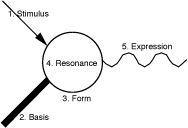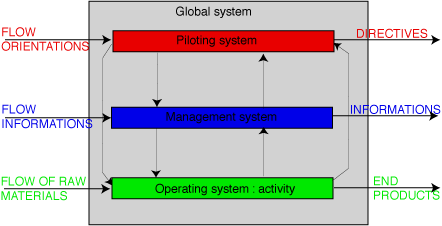
Personality
Personality is the active instrument in the 3 worlds of action, affect and thought.
It is the support of a relatively coherent behaviour, adapted to the environment.
This adaptation and this coherency are based upon intelligence, which does not last as long as wisdom.
Composition
As shows the diagram beneath, the person is made of 3 elements at least

- behaviour, the more external aspect, the easiest to be observed
- consciousness, an inner perception
- body or an envelop of substance, at the 3 levels, physical, affective, and mental.
These envelops are making the unconscious, in a broader sense than the pychological meaning; any being is unaware of its liver, kidneys and teeths - when everything goes right.
- This person is conditioned by natural forces -telluric, astrological forces - and family, social, educative, national inheritances.
- It is also conditioned or stimulated by the ray of the transpersonal Self.
Steps of development
Under the stimulation of the Self, the person is passing through various stages
a) The stage of the building of the person, the various mechanisms might not be coordinated: as show some struggles between desires and beliefs
b) The stage of the pregnancy of the persona, one is defending one's place
c) The stage of the fight between the inner value and the usual functionning (one may be ashamed of one's reaction after a while),
d) The stage of an intense stimulation of the persona (as the self is enhancing it)
e) The stage when the persona is the instrument of the self, a limited yet translucid tool
f) The stage when the persona is created by the spark of spirit
a) This step is lasting quite a long time, it is well-known by its pathologies.
b) It is the stage of the so-called "strong personalities". There exists an incarnation when the personality is asserting itself in a selfish way and achieves its ends, as it has succeeded to co-ordinate its mind, its affective body (only in a relative degree) and its activities; then it achieves its goals. These persons might be artists, political leaders, known people of the community, tradespeople or businessmen.
c) This stage is well-known by the majority of aspirants and by many people of goodwill. The Self is perceived, though vaguely after the 1st initiation, but it does not rule. It is a time of troubles and intestine fights.
The individuation process, described by Jung, begins there: it is the task of surmounting the conditionning. The previous stage of "strong personalities" has been the achievement of these conditionnings. Now, slowly the individual is learning to make its own way in order to be himself (herself).This individuation process will end at the following stage.
d) When the struggle is going to its end, the Self is stimulating its instrument and this makes clearly visible the personality ray - with its excesses - as it is fully receptive to this stimulation. There follows then a brief period when the personality ray is shining, yet it exaggerates its features. Then the stimulation is going on, but the instrument has become refined and is more reflecting this inflowing energy, the egoic ray, and its qualities.
e) At this stage, the Self is radiating and is acting more and more neatly through its instrument. Some limitations are still there, because of familial or national inheritance. Some shocks, blows or gaps may happen yet they are inscribed in the line of service in the long-run work.
f) This is the stage when the centres are directly stimulated from the crown centre. The person is more and more a created image, from the point of tension-spirit. This stage is realized after the 4th initiation, as the previous sage was reached before the 3rd initiation.
The 4 indian casts are a distortion of these stages of development:
- the craftmen are building the matter of their personality
- the tradespeople are exchanging for the sake of their own interest
- the warriors are fighting for unity
- the brahmans are realizing the One.
Remind : The 3 worlds
The person has 3 fields of sentivity and action
- the physical field, vital, sometimes called etheric field
- the emotional field, affective or relational field
- the mental field or intellectual field
These 3 worlds are corresponding to 3 subsystems, each having a shorter or longer cycle of action.
Level | Content | Psyche | Enterprise | Duration | Sub-systems |
Mental | Thought | Convictions, values | Priorities, Stakes | Long-term | Piloting |
Affective | Feeling | Relational sensitivity | Ressources, Means | Middle-term | Management |
Physical | Sensation | Activity, gestures, Reflexes | Effects, Facts, Automatisms | Short-term | Operating |
